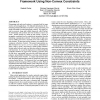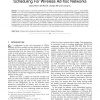424 search results - page 69 / 85 » Sensor Networks for Everyday Use: The BL-Live Experience |
SENSYS
2003
ACM
14 years 1 months ago
2003
ACM
A distinguishing characteristic of wireless sensor networks is the opportunity to exploit characteristics of the application at lower layers. This approach is encouraged by device...
MOBIHOC
2005
ACM
14 years 8 months ago
2005
ACM
Determining node and event locations is a canonical task for many wireless network applications. Yet dedicated infrastructure for determining position information is expensive, en...
SOCIALCOM
2010
13 years 6 months ago
2010
A novel method for quantitatively measuring social interactions on small temporal and spatial scales on the basis of interaction geometry (reduced to the parameters interpersonal d...
MOBIHOC
2006
ACM
14 years 8 months ago
2006
ACM
This paper presents a distributed implementation of RAND, a randomized time slot scheduling algorithm, called DRAND. DRAND runs in O() time and message complexity where is the max...
EWSN
2008
Springer
14 years 8 months ago
2008
Springer
Sensors networks instrument the physical space using motes that run network embedded programs thus acquiring, processing, storing and transmitting sensor data. The motes commercial...


